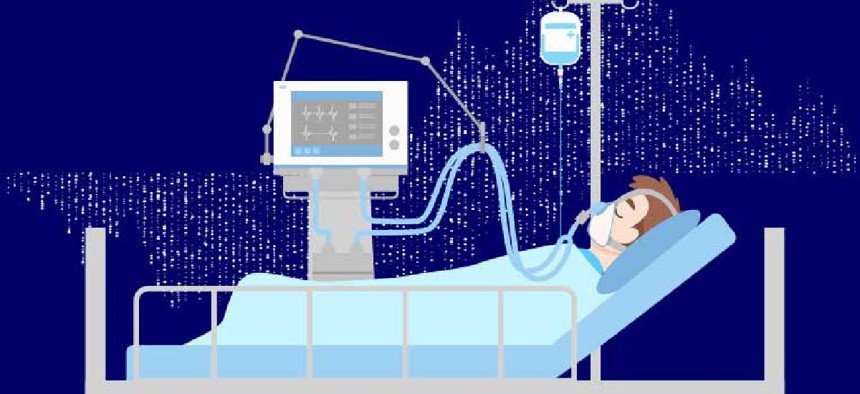DOD’s ‘virtual hospital’ features remote-controlled IVs, ventilators


Connecting state and local government leaders
To expand its range of telehealth services to COVID patients, the Defense Department wants to incorporate “virtual hospital” capabilities -- including interoperable, autonomous and remote-controlled medical devices -- into its cloud-based platforms.
To better prepare for a COVID-19 surge, the Army’s Telemedicine & Advanced Technology Research Center (TATRC) in April issued a call for a National Emergency Tele-Critical Care Network, a set of cloud-based, low-resource, stand-alone health information management systems. NETCCN was designed to support the creation and coordination of virtual critical care wards that would allow health professionals to deliver high-quality critical care to bedsides of COVID-19 patients in field hospitals, small rural health care facilities and even gymnasiums.
Now, TATRC plans to add new capabilities to NETCCN to expand its range of telehealth services and study its utility on a local, regional and national basis for COVID and other disasters.
According to a Dec. 1 request for project proposals, NETCCN plans to incorporate “virtual hospital” capabilities -- including interoperable, autonomous, remote-controlled medical devices -- into its platforms. These capabilities will help deliver critical care in resource-limited environments, increase medical capabilities during disasters and augment the knowledge, skills and abilities of local caregivers.
Two focus areas are proposed:
Accelerating Medical Device Interoperability and Autonomy is focused on accelerating the integration of mechanical ventilators and/or infusion pumps into NETCCN platforms.
Currently, remote care providers delivering critical care to COVID patients have limited ability to observe and control essential medical devices like monitors, intravenous pumps and ventilators because of proprietary interfaces and the lack of remotely controllable functions.
Lightweight hardware solutions, such as mobile devices or inexpensive computing platforms, along with software modifications, would allow remote experts to improve the delivery of advanced critical care, optimize resource utilization and increase the safety of both patients and staff, the TATRC said. Similarly, remote monitoring, remote control “and more advanced capabilities, such as closed loop and autonomous algorithms, may further enhance care delivery to more patients during surge conditions, especially when network resources are fragile,” it said.
NETCNN wants offerors to modify existing devices to improve interoperability, data visualization and remote control.
TATRC is working with MITRE to establish a Device Interoperability and Autonomy Coordinating Center. In partnership with federal agencies and health research organizations, DIACC is working to identify regulatory-compliant projects that could be deployed within 12 months to enhance the quality and impact of “tele-critical care” for COVID patients managed within the NETCCN.
The second focus area, Technology in Disaster Environments (TiDE) Learning Accelerator (TLA), aims to use real-time data from NETCCN to build a continuous learning system for improving disaster health care support.
NETCCN platforms will be able to collect data about telemedicine encounters, as well as data from medical devices, wearables, or passive sensors to better understand what patients and local caregivers need from remote experts and how best to provide it.
TLA would pull and analyze data from NETCCN system resources, health records, real-time vital signs from patients as well as other federal, state, academic and open source information to identify best practices for optimizing clinical outcomes and resource utilization. The military could use those insights during large scale combat operations where there might be massive casualties requiring remote critical care as could public health agencies in response to disasters.
In support of TLA, a prototype TATRC Data Commons and associated research portal is currently hosted at the Johns Hopkins University Applied Physics Lab.
DOD has made $3.3 million available for the Medical Device Interoperability and Autonomy focus area and $2.8 million for TLA over the two-year project. Responses are due Dec. 29. Read the full proposal here.





